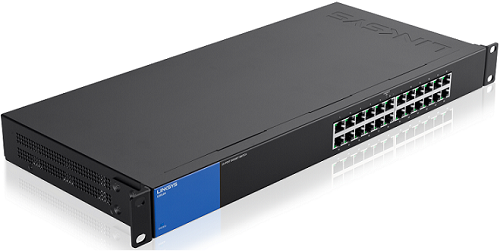
The Linksys LGS124 24-Port Business Gigabit Switch is an unmanaged 24-port switch that offers a quick and easy solution to extend your office network with plug-and-play installation
PRODUCT INFORMATION
You can connect the following devices to the Linksys LGS124:
- Computers
- Routers
- Switches
- Network printers
- Other network devices
The Linksys LGS124 v1 and Linksys LGS124 v2 have different dimensions as listed below:
- LGS124 v1: 440 x 200 x 44 mm (LxWxH)
- LGS124 v2: 440 x 201 x 44 mm (LxWxH)
Gigabit switches can minimize transfer times and allow you to stream high-bandwidth files to connected devices without interference.
The Linksys LGS124 switch complies with the IEEE 802.3, 802.3u, 802.3x, 802.3ab, and 802.3az standards.
No. The Linksys LGS124 can only be mounted on a rack.
No, the switch does not have this capability. Only routers or modems with DHCP capabilities can allow sharing of internet connection between computers. However, a switch can allow more computers to connect to a local network. For the computers to have internet access, the switch should be connected to a router or modem.
The Linksys LGS124 v1 and v2 have a 5-year warranty.
Yes, the switch has a QoS feature. However, the Linksys LGS124 is not a manageable switch; therefore, the QoS setting is predefined and can't be configured or customized.
TROUBLESHOOTING
When this happens, make sure that the network cabling is crimped securely and installed properly.
Follow the steps provided below to resolve this issue:
- 1. Verify if the switch and the computer are connected properly and the indicator lights on the switch are properly lit as outlined below:
-
- System - Solid blue
- Link/Act/GB - Either green or orange and solid or blinking depending on the speed and status of the connection.
- Get more details on the switch’s indicator lights and features.
- 2. Power down everything then power up the switch then do the same to the computer.




